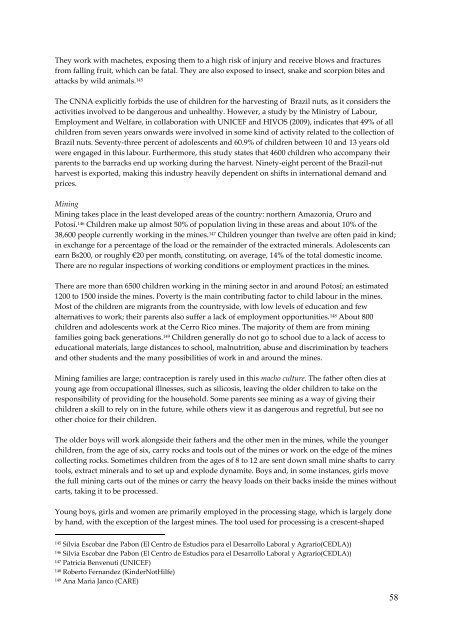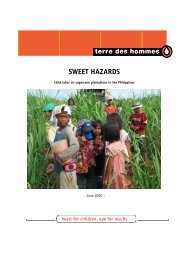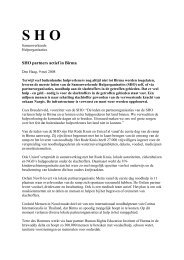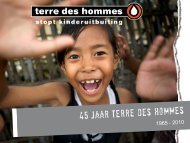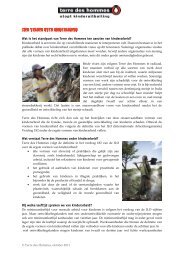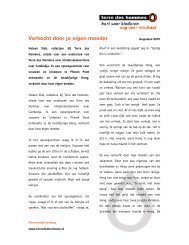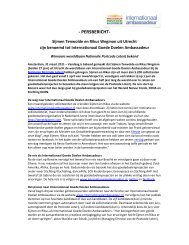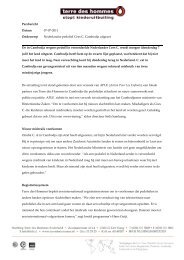Untitled - Terre des Hommes
Untitled - Terre des Hommes
Untitled - Terre des Hommes
- No tags were found...
Create successful ePaper yourself
Turn your PDF publications into a flip-book with our unique Google optimized e-Paper software.
They work with machetes, exposing them to a high risk of injury and receive blows and fractures<br />
from falling fruit, which can be fatal. They are also exposed to insect, snake and scorpion bites and<br />
attacks by wild animals. 145<br />
The CNNA explicitly forbids the use of children for the harvesting of Brazil nuts, as it considers the<br />
activities involved to be dangerous and unhealthy. However, a study by the Ministry of Labour,<br />
Employment and Welfare, in collaboration with UNICEF and HIVOS (2009), indicates that 49% of all<br />
children from seven years onwards were involved in some kind of activity related to the collection of<br />
Brazil nuts. Seventy-three percent of adolescents and 60.9% of children between 10 and 13 years old<br />
were engaged in this labour. Furthermore, this study states that 4600 children who accompany their<br />
parents to the barracks end up working during the harvest. Ninety-eight percent of the Brazil-nut<br />
harvest is exported, making this industry heavily dependent on shifts in international demand and<br />
prices.<br />
Mining<br />
Mining takes place in the least developed areas of the country: northern Amazonia, Oruro and<br />
Potosí. 146 Children make up almost 50% of population living in these areas and about 10% of the<br />
38,600 people currently working in the mines. 147 Children younger than twelve are often paid in kind;<br />
in exchange for a percentage of the load or the remainder of the extracted minerals. Adolescents can<br />
earn Bs200, or roughly €20 per month, constituting, on average, 14% of the total domestic income.<br />
There are no regular inspections of working conditions or employment practices in the mines.<br />
There are more than 6500 children working in the mining sector in and around Potosí; an estimated<br />
1200 to 1500 inside the mines. Poverty is the main contributing factor to child labour in the mines.<br />
Most of the children are migrants from the countryside, with low levels of education and few<br />
alternatives to work; their parents also suffer a lack of employment opportunities. 148 About 800<br />
children and adolescents work at the Cerro Rico mines. The majority of them are from mining<br />
families going back generations. 149 Children generally do not go to school due to a lack of access to<br />
educational materials, large distances to school, malnutrition, abuse and discrimination by teachers<br />
and other students and the many possibilities of work in and around the mines.<br />
Mining families are large; contraception is rarely used in this macho culture. The father often dies at<br />
young age from occupational illnesses, such as silicosis, leaving the older children to take on the<br />
responsibility of providing for the household. Some parents see mining as a way of giving their<br />
children a skill to rely on in the future, while others view it as dangerous and regretful, but see no<br />
other choice for their children.<br />
The older boys will work alongside their fathers and the other men in the mines, while the younger<br />
children, from the age of six, carry rocks and tools out of the mines or work on the edge of the mines<br />
collecting rocks. Sometimes children from the ages of 8 to 12 are sent down small mine shafts to carry<br />
tools, extract minerals and to set up and explode dynamite. Boys and, in some instances, girls move<br />
the full mining carts out of the mines or carry the heavy loads on their backs inside the mines without<br />
carts, taking it to be processed.<br />
Young boys, girls and women are primarily employed in the processing stage, which is largely done<br />
by hand, with the exception of the largest mines. The tool used for processing is a crescent-shaped<br />
145<br />
Silvia Escobar dne Pabon (El Centro de Estudios para el Desarrollo Laboral y Agrario(CEDLA))<br />
146<br />
Silvia Escobar dne Pabon (El Centro de Estudios para el Desarrollo Laboral y Agrario(CEDLA))<br />
147<br />
Patricia Benvenuti (UNICEF)<br />
148<br />
Roberto Fernandez (KinderNotHilfe)<br />
149<br />
Ana Maria Janco (CARE)<br />
58


